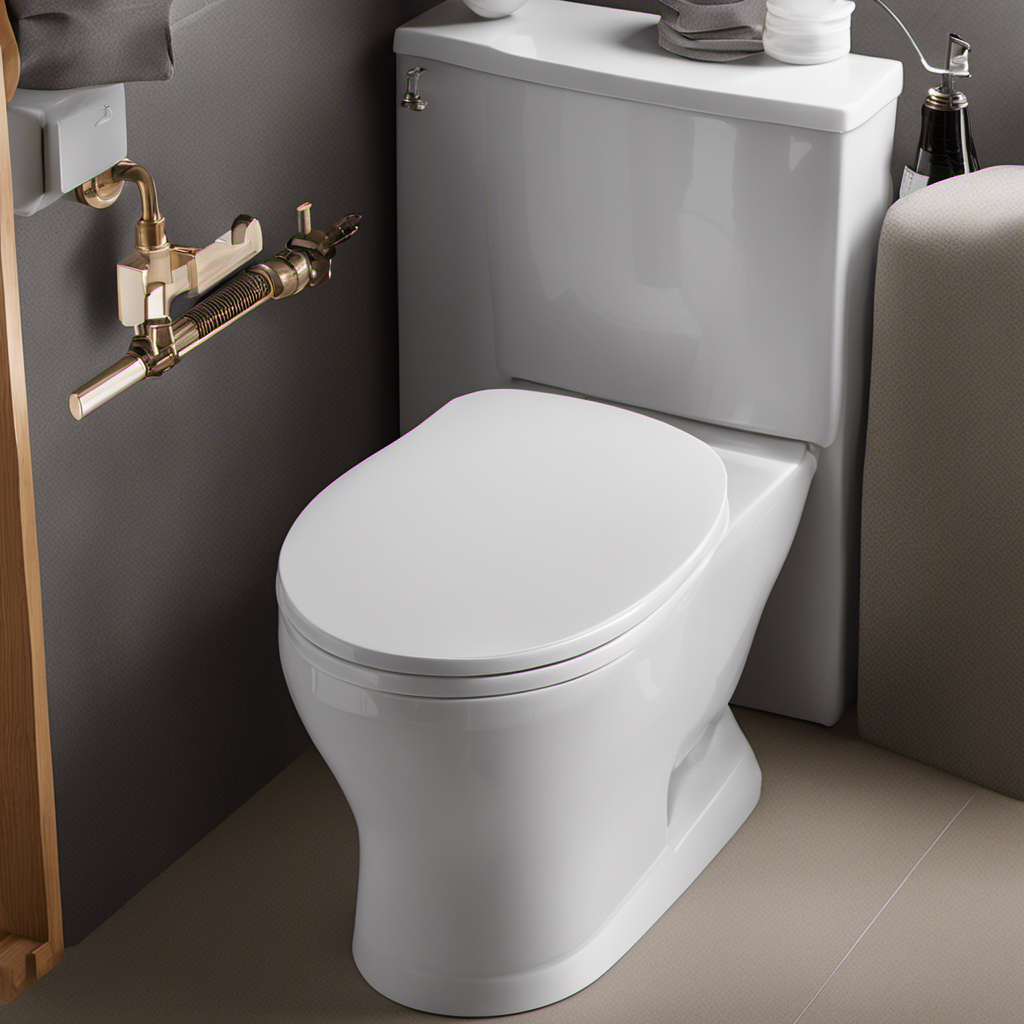Imagine this scenario: you step into your bathroom only to find that your toilet is not functioning properly. It’s time to take matters into your own hands and reset the toilet.
But fear not, for with a few simple steps, you can restore your toilet to its former glory. In this article, we will guide you through the process of resetting your toilet, providing you with the knowledge and tools needed to tackle this task with confidence.
So roll up your sleeves and let’s get started!
Key Takeaways
- Identify the problem (clogged drain, running toilet, leaky tank)
- Gather all necessary tools and materials before starting the reset process
- Shut off the water supply valve connected to the toilet before proceeding
- Empty the tank and bowl to prepare for easier access to internal components for inspection and repair
Understanding the Basics of Toilet Resetting
Before you can reset a toilet, it’s important to understand the basics. Toilet troubleshooting is a crucial skill to have when dealing with common toilet issues.
When faced with a malfunctioning toilet, the first step is to identify the problem. This can include issues such as a clogged drain, a running toilet, or a leaky tank. Once you have determined the cause, you can proceed with the reset process.
Start by turning off the water supply to the toilet and flushing it to drain any remaining water. Next, remove the toilet tank lid and disconnect the water supply line. Carefully unbolt the toilet from the floor and lift it straight up to remove it.
To reset the toilet, reverse these steps, ensuring a proper seal between the toilet and the floor. Understanding these basic steps will help you successfully reset a toilet and resolve common toilet issues.
Gathering the Necessary Tools and Materials
First, you’ll need to make sure you have all the necessary tools and materials for the task. Toilet resetting troubleshooting can be a daunting task, but with the right tools, you can make it easier.
Here’s a list of what you’ll need: a plunger, a wrench, a new wax ring, and a bucket. The plunger will help you clear any clogs, while the wrench will allow you to disconnect the toilet from the floor. The new wax ring is essential for creating a watertight seal, and the bucket will come in handy for catching any water that may spill during the process.
It’s important to gather all these materials before starting to avoid any delays or common mistakes in toilet resetting.
Shutting Off the Water Supply to the Toilet
To complete this step, you’ll need to locate and turn off the water supply valve connected to the toilet. Shutting off the water supply is an essential part of resetting a toilet. It ensures that no water will flow into the tank and bowl during the process. Toilet water supply troubleshooting is a common issue that many people face. Problems with the shut off valve can lead to leaks, low water pressure, or difficulty in shutting off the water completely. Here are some common issues with toilet water shut off valves:
| Common Issues | Troubleshooting |
|---|---|
| Leaks | Tighten the valve with a wrench or replace it if necessary. |
| Low water pressure | Check for any blockages in the valve or the water line. |
| Difficulty shutting off water | Clean the valve and ensure it is fully open or closed. |
Once you have successfully shut off the water supply valve, you can proceed to the next step of emptying the tank and bowl.
Emptying the Tank and Bowl
Once you’ve shut off the water supply valve, you can begin emptying the tank and bowl.
To do this, start by flushing the toilet to remove as much water as possible from the tank and bowl.
Next, locate the tank’s fill valve, which is usually on the left side of the tank. Turn the valve counterclockwise to release any remaining water.
If the tank has a flapper, lift it up to drain any water from the bowl into the sewer pipe.
You can also use a sponge or towel to soak up any excess water in the tank and bowl.
Emptying the tank and bowl is an important step in toilet repair and troubleshooting common toilet issues, as it allows for easier access to the internal components for inspection and repair.
Removing the Toilet From the Floor
When it comes to resetting and securing a toilet properly, one of the key points to consider is flange alignment.
The flange, which is located on the floor, acts as a connection point between the toilet and the waste pipe.
Ensuring that the flange is properly aligned is crucial for creating a secure and leak-free seal.
Flange Alignment for Resetting
Make sure you align the flange correctly before resetting the toilet. The flange is an essential component that connects the toilet to the drainpipe and ensures a proper seal.
To align the flange, begin by inspecting it for any damage or wear. If you notice any cracks or breaks, it may be necessary to repair or replace the flange. Flange repair techniques include using a repair kit or epoxy to fix minor damages.
Once the flange is in good condition, position it over the drainpipe, making sure it is centered and level. One common mistake when aligning flanges is not using the correct size or type of flange. It is crucial to choose a flange that matches the toilet’s drain size and fits securely.
Another mistake is not properly aligning the flange with the floor, which can cause leaks and instability. Take your time to align the flange accurately, ensuring a secure and leak-free connection before resetting the toilet.
Securing the Toilet Properly
To ensure a stable installation, you should securely fasten the toilet using the provided bolts and a wrench. Properly securing the base of the toilet is crucial to prevent any movement or leaks. Here is a systematic process to help you secure the toilet:
| Steps | Instructions |
|---|---|
| 1 | Position the toilet bowl onto the flange, aligning it with the bolt holes. |
| 2 | Place the wax ring onto the flange, ensuring a proper seal. |
| 3 | Carefully lower the toilet onto the wax ring, making sure the bolts protrude through the holes. |
| 4 | Place washers and nuts onto the bolts and hand-tighten them. |
| 5 | Using a wrench, gently tighten the nuts to secure the toilet without over-tightening. |
By following these steps, you can ensure that the toilet is securely fastened and will not move or cause any leaks. Now, let’s move on to inspecting and cleaning the toilet components.
Inspecting and Cleaning the Toilet Components
Take a moment to inspect and clean the various components of your toilet.
Regular maintenance is key to avoiding common toilet problems and ensuring its smooth functioning.
Begin by checking the water level in the tank. If it’s too low, adjust the float valve to increase it.
Next, inspect the flapper valve for any signs of wear or damage. A faulty flapper valve can cause water leakage and inefficient flushing.
Clean the rim holes to prevent clogs and improve flushing performance.
Inspect the supply line for any leaks and tighten any loose connections.
Finally, clean the exterior of the toilet with a mild cleaner to remove any dirt or stains.
Reinstalling and Testing the Reset Toilet
After reinstalling the toilet, it’s important to test its functionality to ensure everything is working properly. Here are some key steps to follow for successful reinstalling techniques and troubleshooting common issues:
-
Check for leaks: Run water into the toilet bowl and inspect the base for any signs of water leakage. If you notice any leaks, tighten the bolts or replace the wax ring.
-
Test the flush: Flush the toilet multiple times to ensure it flushes properly and the water level in the tank refills adequately. If the water doesn’t refill properly, adjust the fill valve or replace it if necessary.
-
Inspect for proper sealing: Carefully inspect the toilet for a tight seal between the base and the floor. If there is any movement or gaps, readjust the toilet or use shims to ensure a secure fit.
Conclusion
So there you have it, the art of toilet resetting. Who would have thought that such a mundane task could be so captivating?
With your newfound knowledge and skills, you are now equipped to tackle any toilet reset with confidence and finesse. Just imagine the satisfaction of successfully reinstalling a toilet, knowing that you have conquered the beast that is the porcelain throne.
It’s a feeling like no other, and one that will surely leave you flushed with pride.
Happy resetting!










